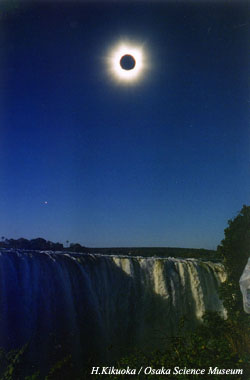 |
地球にもっとも近い恒星−太陽はほとんど水素からできた巨大なガス球です.
中心部で水素がヘリウムに変換する核融合反応が起っていて,
その膨大なエネルギーによって光り輝いています.
母なる太陽として,昔から人々は太陽を信仰の対象とし,畏敬の念を抱いてきました. 左:2001年6月21日のアフリカ皆既日食.撮影地はジンバブエ. 同国とザンビアとの国境付近にあるビクトリアの滝との合成写真. 実際には,ここでは日食は見えませんでした. 資料提供:菊岡秀多(大阪市立科学館) |
|
The Sun is a fixed star near the Earth.
It is a huge gas ball made from hydrogen.
In the central part,
the nuclear fusion reaction which hydrogen changes into helium has occurred,
and it is shining due to the huge energy.
The upper photograph is a total eclipse of the Sun in Africa on June 21, 2001. The photograph was taken in Zimbabwe. (It is a composite photograph with Victoria Falls. The solar eclipse could not actually be seen like this.) By courtesy of H.Kikuoka (Osaka Sciense Museum)  An airplane crossing the sun
An airplane crossing the sun
By courtesy of the Kawabe Cosmic Park | |
Tracks of the Sun
Optical Spectra of the Sun

|
|||
|---|---|---|---|
|
We can see rainbow colors if we pass solar light through a prism.
The light decomposed according to the wavelength is called spectrum.
The intensity distribution of a continuum spectrum resembles blackbody radiation. In a continuum spectrum, a lot of absorption lines called Fraunhofer Lines are seen. 太陽の光(白色光)をプリズムに通すと虹の七色に分れます. このような波長別に分解された光のことをスペクトルと呼んでいます. 赤から紫まで連続的につながった虹色の太陽スペクトルの強度分布は, 絶対温度約6000度の黒体放射によく似ています. 連続スペクトル中にはフラウンホーファー線とも呼ばれる多数の暗線(吸収線)が見られます. | |||
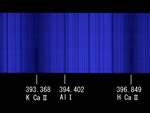 CaII H, K line |
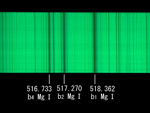 MgI b line |
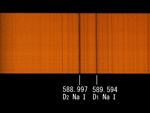 NaI D line |
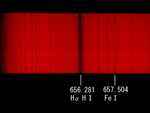 HI Hα line |
|
These are typical absorption lines of the Sun.
These absorption lines are connected with the discoverer's name and called Fraunhofer Lines.
On some absorption lines which are very conspicuous,
Fraunhofer labeled the lines with capital letters or a small letters such as A or b.
The absorption lines by the earth atmosphere were also contained in them.
代表的な太陽の吸収線です. 吸収線は発見者の名前からフラウンホーファー線(Fraunhofer lines)と呼ばれています. フラウンホーファーはよく目立つ吸収線にA, B等のアルファベットの大文字や小文字の記号をつけて識別しました. その中には地球大気による吸収線も含まれていました. By courtesy of Okayama Astrophysical Observatory / NAOJ | |||
|
|
If a slit is applied around east and west rim of the Sun,
and spectra are observed,
we can see that the positions of absorption lines shift from the wavelength of the basis,
because the spectral lines shift by the doppler effect which accompanies solar rotation.
In the upper left figure, A and B are the observed parts, and the arrows express the rotation direction. The lower picture shows corresponding spectra. We can derive the rotation speed of the Sun from the amount of the shift of this absorption line. 太陽の東と西の縁付近にスリットを当ててスペクトルを観測すると, 吸収線の位置がもとの波長よりも少しずれて見えます. これは太陽の自転に伴うドップラー効果によって, スペクトル線が偏移しているからです.
左上:太陽の模式図.A,Bは観測部分,矢印は自転方向.
AのスペクトルでもBのスペクトルでも, 地球大気に由来するスペクトル線は同じ波長です. しかし太陽に由来する吸収線の波長は少しずれています. すなわち,Aでは波長の短い方へ(青方偏移), Bでは波長の長い方へ(赤方偏移), 吸収線がずれて見えます. これは,Aでは,観測者へ近づいてくる方向で回転しているのに対し, Bでは,観測者から遠ざかる方向へ回転してためです. この吸収線のずれの大きさから,太陽の自転速度を求めることができます. | ||
 Let's find a solar rotation speed ! Let's find a solar rotation speed !
By courtesy of the Okayama Astrophysical Observatory / NAOJ | |||
Corona
Prominence
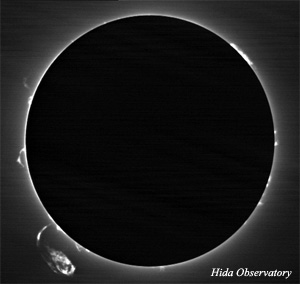
|
The prominent feature like red flame of gas in a solar corona is called prominence. The left was observed on October 22, 2000, the bottom was observed on February 8, 1999, useing the Flare Monitor Telescope of Hida Observatory. 太陽コロナのなかで, コロナの磁場によって支えられて“突起”のように見える部分をプロミネンス(prominence,紅炎)と呼びます.
左:2000年10月22日,京都大学附属飛騨天文台フレアモニタ望遠鏡にて撮影. By courtesy of the Hida Observatory / Kyoto Univ. |

| |
|---|---|
 GIF animation of the prominence on August 3, 2000. GIF animation of the prominence on August 3, 2000. GIF animation of the prominence on July 31, 1992. GIF animation of the prominence on July 31, 1992.
 Various prominence (Detailed explanation) Various prominence (Detailed explanation) | |
Flare
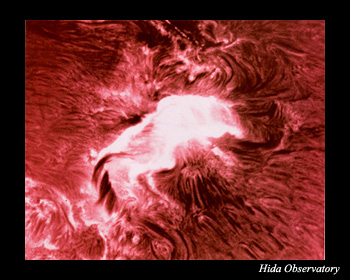
|
左:大規模な2リボンフレア.
京都大学附属飛騨天文台のドームレス太陽望遠鏡(DST)にて撮影.
フレアは,黒点領域の強い磁場のエネルギーが数秒から数分という短い時間に解放され,
数千万度の超高温プラズマや,KeVからMeVの高速電子・陽子ビームが生成され,
強いX線,γ線が放出される現象です. By courtesy of the Hida Observatory / Kyoto Univ. |
|
Flare is a phenomenon, where the surface near the sunspot suddenly brights
and a lot of high energy particles blow off to the interplanetary space.
It is supposed that the energy stored in the magnetic field of the corona over sunspots is released in a short time.
However, we do not know yet why such a rapid explosion takes place in a short time.
A top is the large scale flare observed useing the Domeless Solar Telescope (DST) of Hida Obsevatory.
 The flare in active region of solar rim on March 9, 1995. (MPEG movie)
The flare in active region of solar rim on March 9, 1995. (MPEG movie) The flare which spreads after a filament blows off on August 29, 1997. (MPEG movie)
The flare which spreads after a filament blows off on August 29, 1997. (MPEG movie)
| |
Spicule
Sunspot
Granule
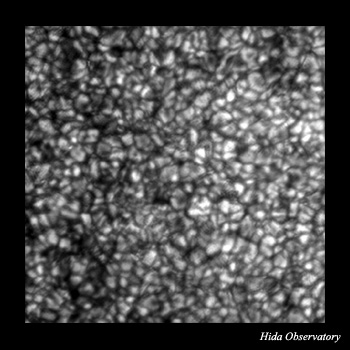
|
粒状斑(granule)とは,太陽表面に見える粒状の濃淡で,
10分ほどの寿命で現れたり消えたりします.
左:粒状斑の高分散画像.光球面中央. 飛騨天文台ドームレス太陽望遠鏡(DST)にて1999年8月30日撮影.
|
|
Granule is the granular shade which is visible to the solar surface.
It appears in about 10 minutes, or disappears.
The upper left is the high resolusion image of granule observed on August 30, 1999, useing the Domeless Solar Telescope (DST) of Hida Obsevatory. By courtesy of the Hida Observetory / Kyoto Univ. | |
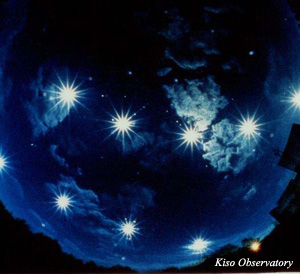
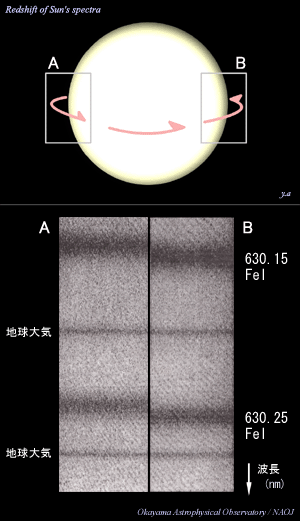
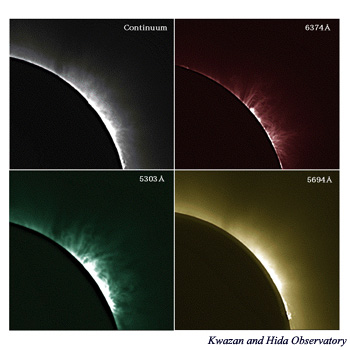
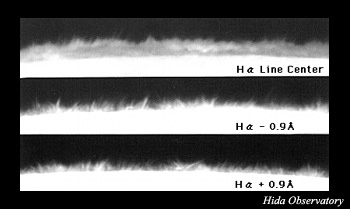
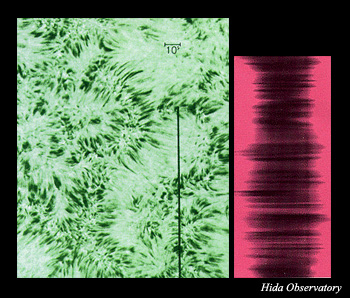
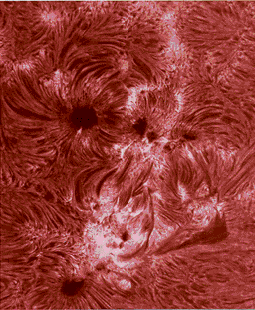
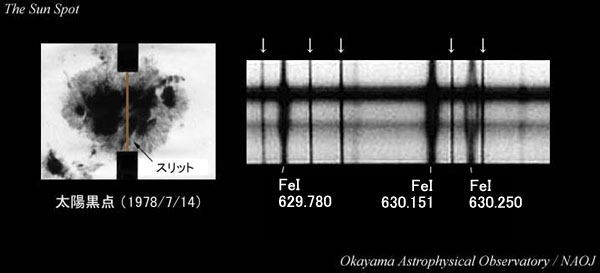
 Go to Submenu
Go to Submenu Go to Menu
Go to Menu